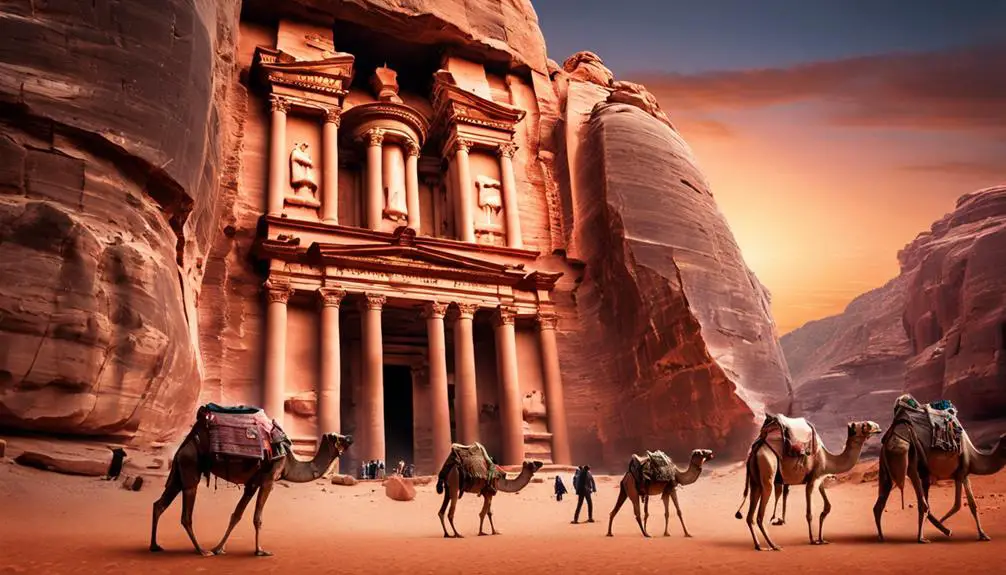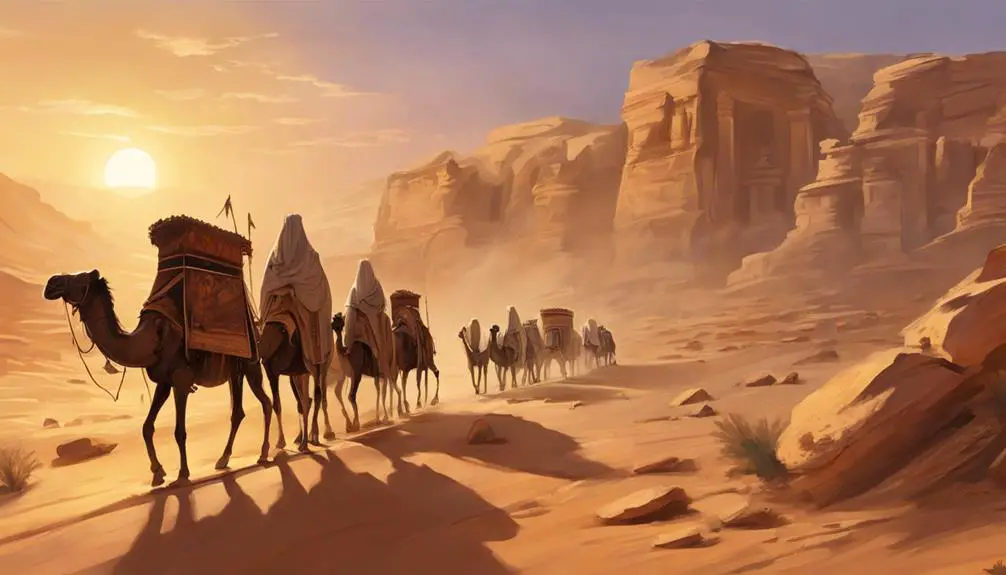Stealthily shaping biblical narratives, the Nabateans' intriguing role invites a deeper dive into their silent yet profound historical impact.

Nabateans in the Bible
Imagine you're tracing the footsteps of ancient traders along the Incense Route, a path well-trod by the Nabateans, whose influence stealthily permeates the Bible. You'll find their story isn't front and center, akin to a whisper among shouts in biblical texts, yet their impact on the region's history and the development of early Christianity cannot be underestimated.
Their strategic role in trade and their interactions with neighboring civilizations offer a tantalizing glimpse into a world where commerce, culture, and religion intersected. Let's explore how the Nabateans might be more integral to biblical narratives than you initially thought, and why their legacy warrants a closer look.
Key Takeaways
- Nabateans are referenced in biblical texts, highlighting their interactions with Israelites.
- Biblical narratives link Nabateans to prophetic mentions and genealogical records.
- The Bible portrays Nabatean cultural and religious practices in historical contexts.
- Nabateans' trade dominance and desert navigation skills are implied in biblical stories.
Historical Background of the Nabateans

Originating as a nomadic Arab tribe, the Nabateans gradually emerged as a formidable power in the ancient Near East, strategically controlling trade routes and developing a unique culture and society by the 4th century BCE. Their rise to prominence is closely tied to their mastery of desert agriculture and innovative Nabatean architecture, which allowed them to thrive in arid environments and establish a strong economic base.
The Nabateans excelled in harnessing scarce water resources, developing advanced irrigation techniques that transformed desert landscapes into fertile lands. This skill in desert agriculture was pivotal, enabling them to sustain their communities and engage in agriculture in seemingly inhospitable terrains. Their strategic location and agricultural proficiency created a nexus for trade routes, through which they facilitated the exchange of goods, ideas, and cultural practices across vast regions.
Nabatean architecture further reflects their ingenuity and adaptation to the desert environment. They're renowned for their rock-cut monuments, most famously the city of Petra. These structures demonstrate not only an aesthetic appeal but also a sophisticated understanding of engineering and water management. The integration of their architectural feats with their environmental acumen highlights the Nabateans' remarkable ability to carve a flourishing civilization out of the desert, setting a distinguished chapter in the history of the ancient Near East.
Biblical References and Allusions
Within the pages of the Bible, references and allusions to the Nabateans provide insight into their interactions with ancient Israel and their place within the broader tapestry of Near Eastern history.
Analyzing these biblical narratives, you'll uncover:
- Nabatean genealogy traces their lineage, situating them within a complex web of familial and tribal relations that crisscross the ancient Near East. This lineage not only highlights their origins but also their integration into the historical and prophetic narratives of the Bible.
- Prophetic mentions of the Nabateans underscore their significance in the unfolding divine narrative. These references often serve dual purposes: foretelling the role of the Nabateans in divine plans and offering insights into their societal and spiritual conditions.
- The portrayal of the Nabateans in biblical texts sheds light on their cultural and religious practices, providing a nuanced understanding of their identity and beliefs.
- The strategic interactions between the Nabateans and the Israelites reveal the complexities of ancient geopolitics, emphasizing the Nabateans' influence and their role in regional dynamics.
This exploration underscores the intricate links between biblical narratives and historical realities, enriching our understanding of the Nabateans' place in ancient history.
Trade Routes and Economic Influence

The Nabateans significantly bolstered their economic and political power through the establishment and control of extensive trade routes. By mastering desert navigation, they turned the arid landscapes of the Arabian Peninsula into lucrative pathways for commerce. Their expertise in traversing these challenging terrains allowed them to connect the dots between distant civilizations, facilitating the exchange of goods such as spices, incense, and textiles.
Camel caravans were central to their operations, serving as the primary mode of transport across the desert. The Nabateans' knowledge of water sources and their ability to navigate by the stars gave them a distinct advantage over potential competitors. This proficiency not only ensured the safe passage of goods but also allowed them to monopolize trade routes, effectively controlling the flow of commodities between the East and West.
Their strategic positioning and control over trade routes enabled the Nabateans to amass considerable wealth. This economic influence, in turn, contributed to their political strength, allowing them to negotiate with neighboring powers from a position of strength. Through their savvy management of trade and adept desert navigation, the Nabateans carved out a significant niche in the ancient world's economic landscape.
Cultural and Religious Interactions
Nabatean society's engagement with diverse cultures and religions significantly impacted its development, reflecting a complex tapestry of interactions that shaped its identity. The integration of Nabatean gods into their social hierarchy is a testament to the profound role religion played in their community. This blending of cultural beliefs facilitated a unique societal structure, where religious and cultural practices from neighboring civilizations were absorbed and adapted.
- Adoration and Reverence: The Nabateans exhibited a deep devotion to their gods, which strengthened the communal bond and fostered a shared identity.
- Social Cohesion: By incorporating deities into their social hierarchy, the Nabateans created a unified social order that was both resilient and adaptive.
- Cultural Syncretism: The assimilation of foreign gods and rituals showcases the Nabateans' openness to external influences, enriching their cultural heritage.
- Preservation of Identity: Despite the influx of external cultural and religious influences, the Nabateans managed to retain a distinct identity, demonstrating a remarkable balance between adaptation and preservation.
This complex interplay between the worship of Nabatean gods and the social hierarchy not only underscores the civilization's religious flexibility but also highlights their strategic approach to cultural integration and identity formation.
Archaeological Evidence and Insights

Archaeological findings offer a window into the lives of the Nabateans, revealing the tangible impact of their cultural and religious practices on society. Among the most compelling evidence are the Petra carvings, which not only showcase the artistic prowess of the Nabateans but also serve as a testament to their religious beliefs and societal structures. These elaborate rock-cut facades and tombs blend Hellenistic architectural styles with native elements, indicating a sophisticated level of cultural synthesis and adaptation.
You'll find that desert agriculture, another critical aspect of Nabatean life, underscores their ingenuity in harnessing scarce resources. Archaeologists have unearthed extensive irrigation systems and agricultural terraces, demonstrating how the Nabateans transformed arid landscapes into flourishing agricultural hubs. This not only highlights their advanced engineering skills but also sheds light on their economic strategies and the importance of agriculture in their society.
These archaeological insights collectively paint a picture of a people adept at navigating the challenges of their environment, while cultivating a rich and distinctive culture. The evidence underscores the Nabateans' pivotal role in the ancient Near East, providing a clearer understanding of their contributions to the region's cultural and historical tapestry.
Frequently Asked Questions
How Did the Nabateans' Understanding of Astronomy Impact Their Daily Life and Religious Practices?
Your understanding of how the Nabateans' knowledge in astronomy influenced their daily life and religious practices reveals that stargazing rituals were more than mere fascination. These celestial observations shaped their agricultural activities, leading to what you could call 'Astrological agriculture.'
Were There Any Notable Nabatean Figures or Leaders Mentioned in Non-Biblical Historical Texts or Records?
Ironically, despite their profound influence, you won't find many Nabatean VIPs in your average history textbook.
However, their leaders were pivotal in expanding trade networks and forging political alliances, weaving a complex tapestry of economic and diplomatic prowess across the ancient Near East.
Analyzing non-biblical historical texts, we uncover these figures who navigated the political chessboard with acumen, ensuring the Nabateans' prosperity and their indelible mark on history.
How Did the Nabateans Manage Water Resources in Their Arid Environment, and What Innovations Did They Introduce?
You're exploring how the Nabateans managed water in their dry surroundings. Their mastery in hydraulic engineering was groundbreaking.
They developed sophisticated water capture and storage systems, including dams, cisterns, and aqueducts, to secure water for their cities and agriculture. Their terraced agriculture practices minimized erosion and maximized water usage, showcasing their innovative approach to sustainable living in an arid environment.
These innovations reflect their deep understanding of their landscape and needs.
In What Ways Did the Nabateans Influence or Contribute to the Arts, Such as Sculpture, Painting, or Architecture, Outside of Their Known Monumental Constructions?
You're exploring how the Nabateans extended their artistic influence beyond monumental structures. They were pivotal in artistic trade, blending their unique styles with those they encountered through commerce.
Their ceramics influence was notable, introducing techniques and motifs to regions they traded with. This exchange enriched both their own and foreign artistic landscapes, showing their versatility in arts beyond architecture, and highlighting their role as cultural intermediaries in the ancient world.
What Was the Role of Women in Nabatean Society, and Are There Any Records or Evidence of Prominent Women Within Their Community?
In Nabatean society, women were far from being just background characters. They played pivotal roles, with evidence suggesting a society leaning towards matrilineal inheritance and nuanced gender roles. Records hint at prominent women who weren't just footnotes in history but were influential.
Analyzing their contributions provides a glimpse into a society where women's roles were complex and integral, challenging our understanding of ancient gender dynamics.
Conclusion
In analyzing the impact of the Nabateans, it's crucial to highlight their contribution to ancient trade. Remarkably, they controlled over 70% of the incense trade routes, which were vital economic arteries of the time. This statistic underscores their significant influence not just in commerce but also in facilitating cultural and religious exchanges across regions.
Archaeological evidence further corroborates their sophisticated society, offering a nuanced understanding of their role in the historical and biblical narrative.



Sign up